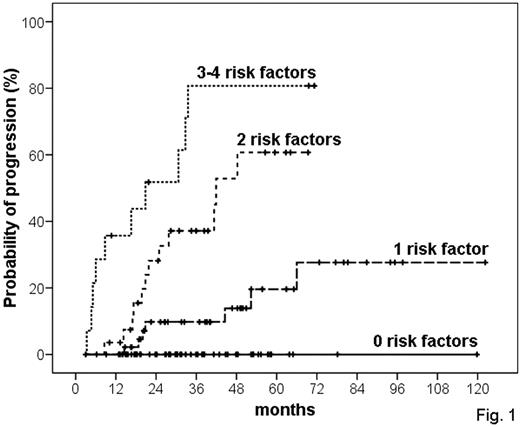Abstract
Abstract 1796
Poster Board I-822
The rationale of the study stems from three considerations: i) to date, few clinical predictors of asymptomatic multiple myeloma (MM) progression are available; ii) no study has assessed the role of beta-2-microglobulin (B2M) on risk of asymptomatic MM progression; iii) B2M is a serum marker of tumor burden and represents a key variable of the ISS staging system for symptomatic MM. The study aims at assessing the impact of B2M on risk of asymptomatic MM progression. The study was based on a consecutive series of 148 asymptomatic MM diagnosed according to the IMWG. Cumulative probability of progression to symptomatic MM was calculated from diagnosis of asymptomatic MM to progression to symptomatic disease according to IMWG. Survival analysis was performed by Kaplan-Meier method using log-rank to test for associations. Cox proportional hazard regression was used to build a multivariate model. Harrell's c-statistics was used to evaluate the discriminatory value of the prognostic models. Clinical features at asymptomatic MM diagnosis were as follows: median age 67 years, male:female ratio 1.02, previous MGUS 32/148 (21.6%), IgG monoclonal component (MC) 113/148 (76.4%), IgA MC 32/148 (21.6%), light chain MC 3/148 (2.0%), median serum monoclonal component (sMC) 1.1 g/dl, positive urinary immunofixation 27/148 (18.2%), median urinary monoclonal component (uMC) 98 mg/24h, median bone marrow plasma cell percentage (BMPC%) 15%, median B2M 2.0 mg/l, median albumin 4.3 g/dl, median C reactive protein 0.3 mg/l. After a median follow-up of 48 months, 29/148 asymptomatic MM progressed to symptomatic disease, accounting for a 29.5% 5-year probability of progression. According to Youden's index, best cut-off values for prediction of progression were 2.5 mg/l for B2M, 1.5 g/dl for sMC, 500 mg/24h for uMC, and 20% for BMPC%. Univariate analysis identified B2M >2.5 mg/l (5-year risk: 64.5%; HR=3.85; p<.001), sMC >1.5 g/dl (5-year risk: 49.1%; HR=5.76; p<.001), uMC >500 mg/24h (5-year risk: 68.7%; HR=6.60; p<.001) and BMPC% ≥20% (5-year risk: 50.2%; HR=5.77; p<.001) as predictors of progression to symptomatic MM. Clinical variables not associated with progression to symptomatic MM (p≥0.05 in all cases) were age, sex, sMC type, polyclonal Ig reduction, albumin, C reactive protein, Hb, calcium, creatinine, and previous MGUS. Multivariate analysis identified B2M >2.5 mg/l (HR=3.57; p=.001) as an independent predictor of progression to symptomatic MM, along with sMC >1.5 g/dl (HR=4.07; p=.003), uMC >500 mg/24h (HR=3.66; p=.015) and BMPC% ≥20% (HR=3.20; p=.007). Based on multivariate analysis, B2M, sMC, uMC, and BMPC% were combined into a model for predicting progression to symptomatic MM. This model stratified patients into four risk groups: very low risk (0 risk factors: 5-year risk 0%), low-intermediate risk (1 risk factor: 5-year risk 19.6%), high-intermediate risk (2 risk factors 5-year risk: 60.7%), and high risk (3 or 4 risk factors 5-year risk 80.7%) (Fig. 1). Three lines of evidence suggest that B2M may improve the conventional risk stratification model for prediction of asymptomatic MM progression defined by sMC, uMC, and BMPC%. First, B2M >2.5 mg/l adds prognostic information within the low risk group characterized by sMC '1.5 g/dl, uMC '500 mg/24h and BMPC <20% (p=.005), by segregating a very low risk group of patients with B2M<2.5 mg/l who never progressed (5-year risk: 0%). Second, B2M >2.5 mg/l adds prognostic information within the high risk group defined by sMC >1.5 g/dl and/or uMC >500 mg/24h and/or BMPC ≥20% (p=.034) by segregating a high risk group of patients with B2M >2.5 mg/l who are virtually all projected to progress (5-year risk: 89.0%). Third, based on c-statistics, the prognostic model including B2M along with sMC, uMC, and BMPC% (c-statistics=.760; SE=.045) allowed to predict asymptomatic MM progression better than a model based only on sMC, uMC, and BMPC% (c-statistics=.726; SE=.049). The implications of our results are twofold: i) B2M predicts progression of asymptomatic MM to symptomatic disease independent of conventional risk factors (sMC, BMPC%, light chain burden); ii) B2M refines the conventional model for predicting progression to symptomatic MM by allowing the identification of a very low risk group of patients who never progress and a high risk group of patients who are virtually all projected to progress.
No relevant conflicts of interest to declare.
Author notes
Asterisk with author names denotes non-ASH members.


This feature is available to Subscribers Only
Sign In or Create an Account Close Modal